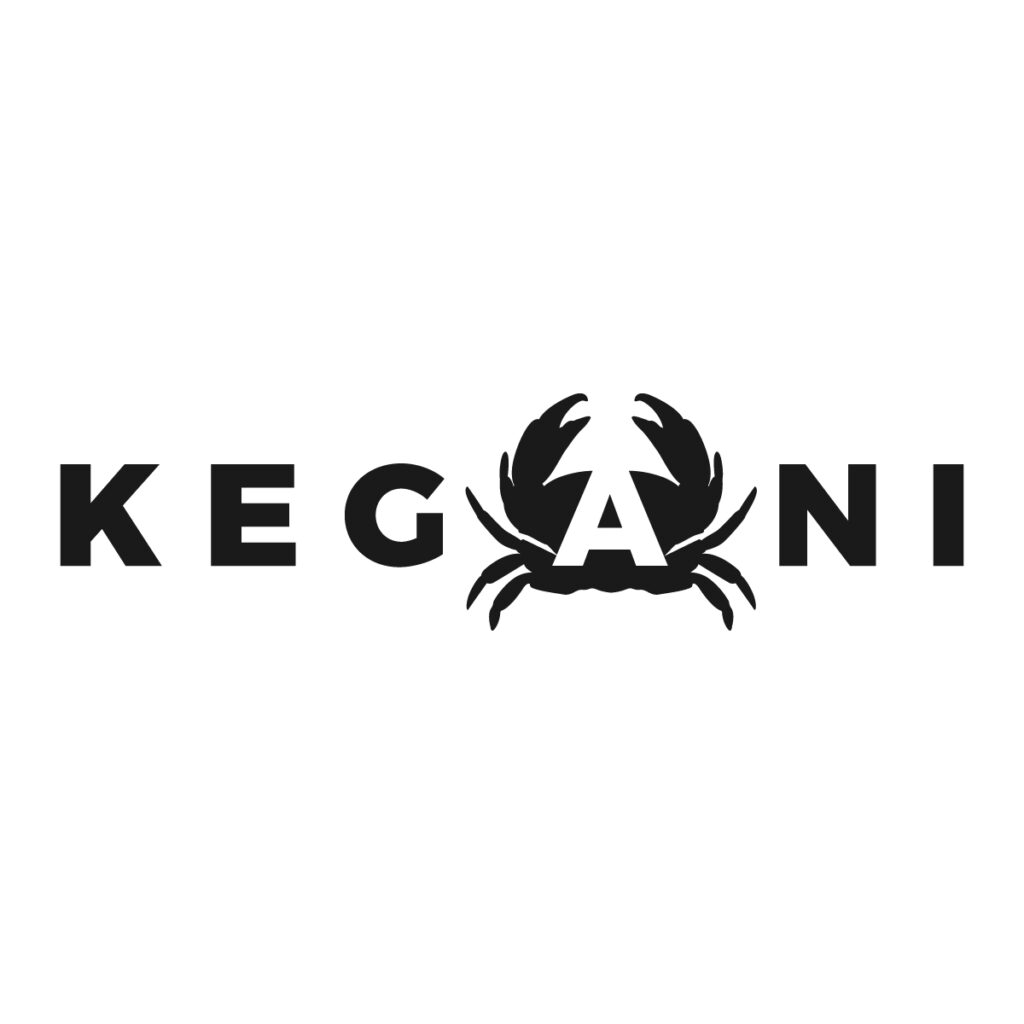In today’s competitive knife market, a sharp blade alone won’t cut it. Customers demand more – greater durability, enhanced performance, and eye-catching aesthetics. This is where knife blade coatings, such as PVD, Cerakote, DLC, and Titanium, come into play.
These specialized coatings, applied in thin layers on the blade’s surface, are like a secret weapon for your knife.
In this article, we’ll explore the different types of knife blade coatings, their benefits, and their applications. By the end of this guide, you’ll be a coating connoisseur, ready to source the perfect knives for your business.
So, grab a seat, and let’s get coated!
What are Knife Blade Coatings?
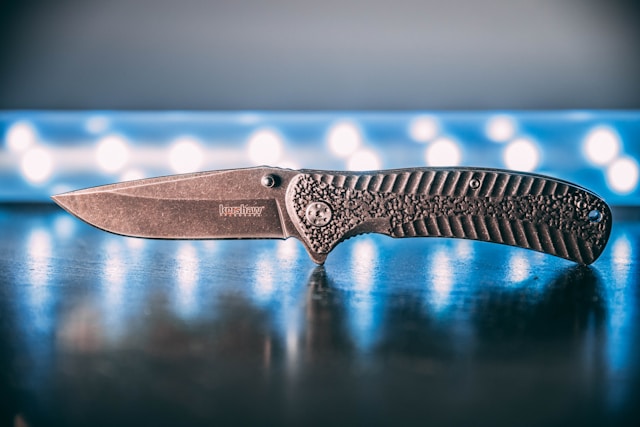
In a nutshell, knife blade coatings are thin layers of material applied to the surface of a blade to give it superpowers – well, almost. Think of it like a protective shield for your knife. But they are typically just a few microns thick.
Purposes of blade coatings
Enhanced Durability
They protect the blade from scratches, chipping, and corrosion, making your knives more resilient and longer-lasting. This is especially crucial for knives used in tough environments like commercial kitchens or outdoor adventures.
Improved performance
Some coatings reduce friction, allowing for smoother, easier cuts and simpler sharpening. Others offer non-stick properties, which is a godsend for tasks like food prep where you don’t want your sliced tomatoes sticking to the blade.
Enhanced aesthetics
Blade coatings come in a range of colors and finishes that can take your knives from drab to fab. A sleek black DLC coating or a bold blue PVD finish can be a major selling point for customers looking to add some style to their cutting arsenal.
Here are some common areas where coated blades shine:
- Kitchen knives: Non-stick coatings make food prep a breeze
- Hunting and outdoor knives: Durable coatings withstand tough conditions
- Tactical and military knives: Corrosion-resistant coatings are a must
- Scissors and shears: Friction-reducing coatings enable smooth, precise cuts
- Surgical instruments: Antimicrobial coatings help maintain sterility
- Industrial cutting tools: Wear-resistant coatings prolong tool life
There are several common types of knife blade coatings, each with their characteristics and advantages:
1. DLC (Diamond-Like Carbon) Coating
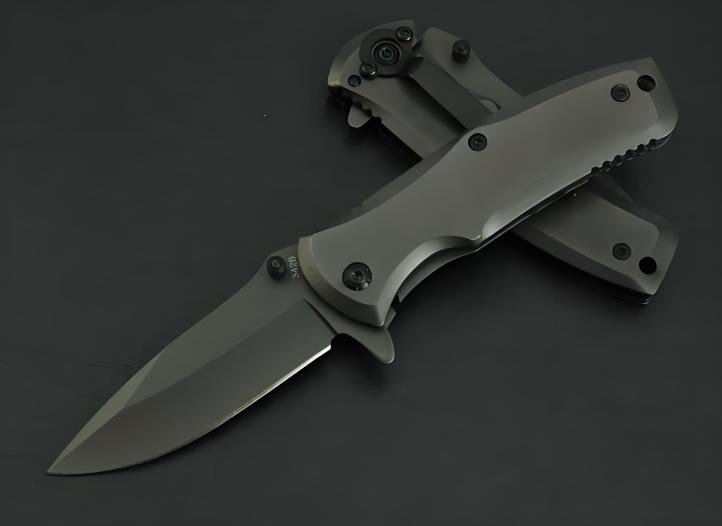
DLC coating involves depositing a thin layer of carbon onto the blade’s surface, resulting in a hardness level that approaches that of diamonds. This makes it the most durable on the market.
Advantages
- Unmatched Hardness: 80-95 HRC
- Low Friction: A low friction coefficient of 0.05-0.1, ensures smoother cutting action and less sticking
- Corrosion Resistance: excellent resistance to moisture and chemicals
- Non-reflective black color
Downsides
- Higher Cost: DLC coating is typically more expensive than other options due to the complex deposition process.
- Brittleness: Some DLC coatings, depending on composition, can be brittle and prone to cracking or chipping under high stress or impact.
- Limited Color Options: they are only available in black
Applications
A DLC-coated knife is ideal for a collector who wants a high-end, exceptionally hard blade for display or occasional use. Also, it is used in the medical industry for its biocompatibility, corrosion resistance, and low friction properties.
2. PVD (Physical Vapor Deposition) Coating
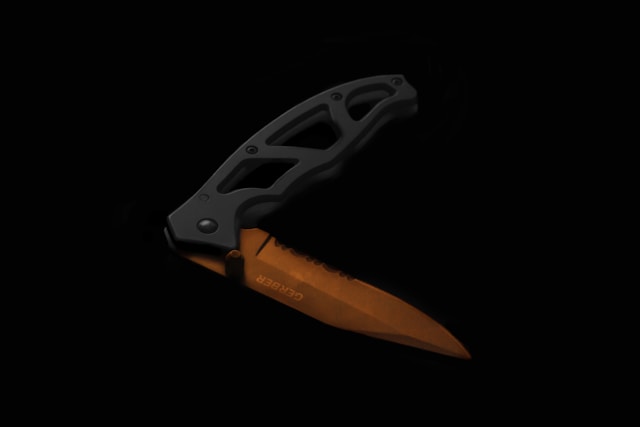
PVD, or Physical Vapor Deposition, is like a high-tech spray tan for your blade. It involves vaporizing a coating material in a vacuum chamber and then depositing it onto the blade’s surface at a molecular level. The result? An impossibly thin, even layer.
Advantages
- High hardness rating: 70-90 HRC
- Enhanced Corrosion Resistance
- Thin and Discreet: Low friction coefficient for smooth cutting and less sticking
Downsides
- Can Be Prone to Chipping: While incredibly hard, PVD coatings can be brittle under extreme impact.
- Limited Color Options: Traditional PVD colors stick to the classics – gold, black, and silver.
Applications
A PVD-coated knife is ideal for a chef who needs a sharp, corrosion-resistant blade for daily use in a busy kitchen. But it may not be the best choice in heavy-duty chopping tasks, such as batoning wood. A more flexible and impact-resistant coating like Cerakote, or even a well-maintained uncoated blade, would be a more suitable choice.
Start Working with a Professional Now
Common PVD Coatings
- Titanium Nitride (TiN): The most common PVD coating, known for its flashy gold color and impressive hardness. Perfect for everyday carry knives that want to make a statement.
- Zirconium Nitride (ZrN): Offers a sleek black finish and even greater hardness than TiN. Often found on high-end knives and tactical blades.
- Chromium Nitride (CrN): Provides exceptional wear resistance and corrosion protection. Suitable for knives used in harsh environments.
| Property | Zirconium Nitride (ZrN) | Titanium Nitride (TiN) | Chromium Nitride (CrN) |
|---|---|---|---|
| Color | Black | Gold | Silver-gray |
| Hardness (HRC) | 80-85 | 70-80 | 70-75 |
| Wear Resistance | Excellent | Good | Excellent |
| Corrosion Resistance | Excellent | Good | Exceptional |
| Max Working Temperature | 600°C | 600°C | 700°C |
| Common Applications | High-end knives, tactical blades | Everyday carry knives | Knives used in harsh environments |
3. Cerakote
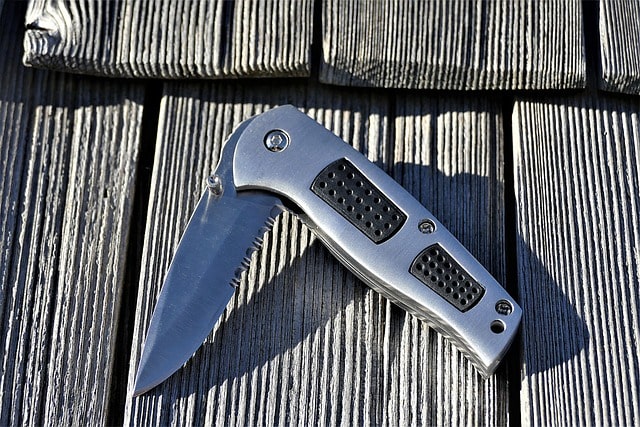
Cerakote is a ceramic-based coating known for its exceptional durability and wide range of color options.
Advantages
- Vibrant Color Options: This is a major advantage for brands seeking to differentiate their products.
- Good Impact Resistance: Cerakote coatings exhibit good flexibility, making them less prone to chipping or cracking under impact compared to some DLC and PVD coatings.
- Relatively high hardness
Downsides
- Can be prone to scratches and fading
- Thicker Coating: generally thicker than PVD or DLC, impacts the blade’s sharpness and fine-cutting ability
- More Difficult to Apply Evenly: Achieving a uniform Cerakote coating requires specialized equipment and expertise
Applications
The coating’s properties make it perfect for safeguarding knives used in tough applications like hunting, fishing, and outdoor pursuits.
4. Powder coating
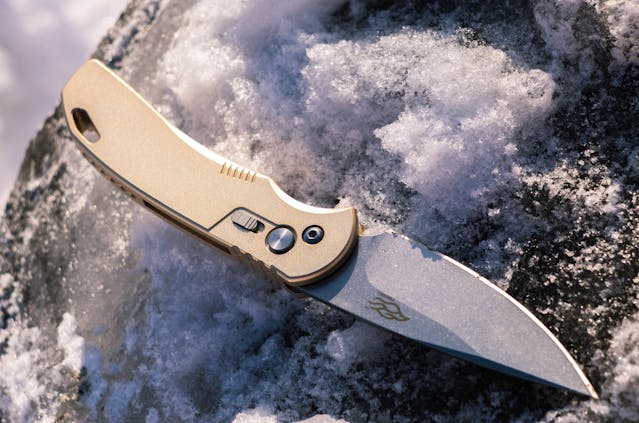
Powder coating is a dry finishing process that involves applying a powdered coating material to a surface and then curing it under heat to form a durable, smooth finish.
Advantages
- Durability and Toughness: Powder coatings provide excellent resistance to corrosion, and impacts, making them suitable for knives used in harsh environments.
- Wide Range of Colors and Finishes: a vast array of colors and finishes, from matte to glossy, metallic to textured, allowing for unique and customizable designs.
- Eco-Friendly: Powder coating is an environmentally friendly process, as it emits zero or near-zero VOCs (volatile organic compounds) and produces minimal waste compared to liquid coatings.
- Cost-Effective: requires less material and energy than liquid coatings, and overspray can be recycled, reducing waste.
Downsides
- May not be as hard as other coatings
- Specialized Equipment Needed: Requires a powder coating gun and curing oven, which can be costly for small operations.
- Thickness Control Issues: Tends to build up more on edges and corners, making uniform coating challenging.
Here’s a table comparing Powder coating, Cerakote, PVD (Physical Vapor Deposition) Coating, and DLC (Diamond-Like Carbon) Coating in terms of hardness, corrosion resistance, impact resistance, thickness, and price:
| Property | Powder Coating | Cerakote | PVD Coating | DLC Coating |
|---|---|---|---|---|
| Hardness | Low to Medium | High | Very High (70-90 HRC) | Extremely High (80-90 HRC) |
| Corrosion Resistance | Good | Excellent | Excellent | Excellent |
| Impact Resistance | Good | Good | Moderate | Moderate to High (depending on composition) |
| Thickness | Thick (50-100 µm) | Thin (18-25 µm) | Very Thin (1-4 µm) | Ultra-Thin (0.5-3 µm) |
| Price | Low | Moderate | High | Very High |
5. Teflon (PTFE) Coating
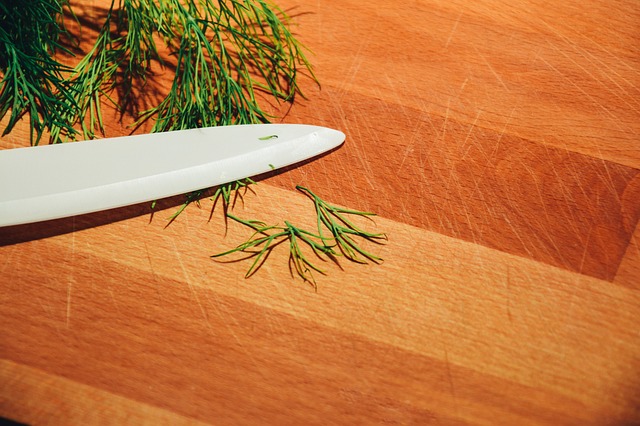
Teflon, or PTFE (polytetrafluoroethylene), is a synthetic fluoropolymer known for its non-stick properties.
Advantages
- Low Friction and Non-Stick: Forms a smooth, slippery surface that prevents materials from sticking, ideal for cutting sticky items like cheese or dough.
- Good Wear Resistance: Offers decent protection against minor abrasions.
- Chemical Inertness: Doesn’t react with most substances, making it versatile for various environments.
- Electrical Insulation: Provides excellent electrical insulation, useful for specialized applications.
Downsides
- Lower Hardness: Not as hard as coatings like Cerakote or PVD, making it more prone to scratches and abrasion.
- Wear Over Time: Can wear off with extended use, especially in high-friction cutting tasks.
- Limited Durability: Less durable compared to harder coatings, potentially requiring more frequent reapplication.
Applications
Teflon coating is commonly used on utility knives, as it helps to prevent adhesives, paint, and other sticky substances from building up on the blade, making it easier to cut through various materials.
6. Gun Blue
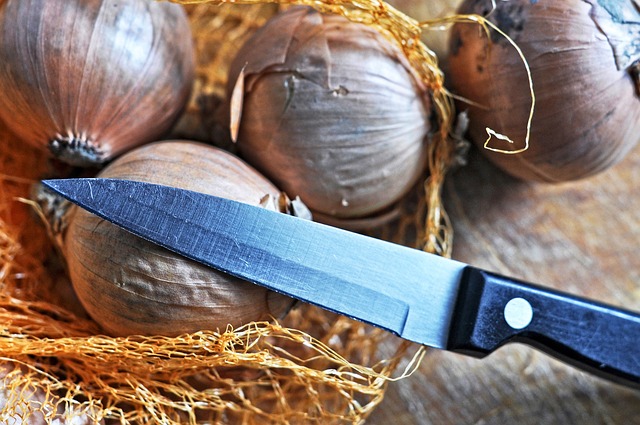
Gun blue, also known as bluing or black oxide, is a chemical conversion coating that forms a thin layer of magnetite (Fe3O4) on the surface of a blade. This coating provides a dark blue-black color and helps protect the blade from corrosion.
Advantages
- Aesthetically pleasing deep blue-black color
- Improves corrosion resistance by forming a protective oxide layer
- Relatively inexpensive and easy to apply
- Enhances the classic, traditional look of the blade
Drawbacks
- Provides limited wear resistance and can wear off over time
- May require periodic re-application to maintain the protective properties
- Some modern stainless steel alloys may not be suitable for gun blue treatment
Applications
Some people apply gun blue to carbon steel kitchen knives to prevent rust and enhance the appearance
FAQ: Knife Blade Coatings
What are the benefits of knife blade coatings?
Blade coatings enhance durability, reduce friction, provide corrosion resistance, and improve aesthetics. They make knives more resilient and longer-lasting, especially in tough environments.
Which is the hardest knife blade coating?
DLC (Diamond-Like Carbon) coating is the hardest, with a hardness level approaching that of diamonds (80-95 HRC).
Are blade coatings suitable for kitchen knives?
Yes, non-stick coatings like Teflon and corrosion-resistant coatings like PVD are ideal for kitchen knives as they make food prep easier and maintain blade quality.
What is the most durable coating for outdoor knives?
Cerakote is known for its exceptional durability and impact resistance, making it perfect for outdoor and hunting knives.
Do blade coatings affect knife sharpening?
Some coatings, like Cerakote, are thicker and may slightly impact sharpening. However, most coatings like PVD and DLC are thin enough not to interfere significantly.
Can blade coatings wear off over time?
Yes, coatings like Teflon can wear off with extended use, especially in high-friction tasks. Harder coatings like DLC and PVD are more durable but can also wear under extreme conditions.
Sourcing knives with Kegani
For wholesalers, retailers, and brand owners sourcing knives from China, understanding the nuances of blade coatings is essential. By carefully considering application quality, durability, cost, aesthetics, and supplier expertise, you can make informed decisions and source knives that meet the highest standards.
Remember, partnering with a reliable sourcing expert like Keganico.com can streamline the process. We connect you with reputable Chinese manufacturers, ensuring you receive high-quality knives with the right coatings to meet your customers’ demands. Request a free quote from us today!
